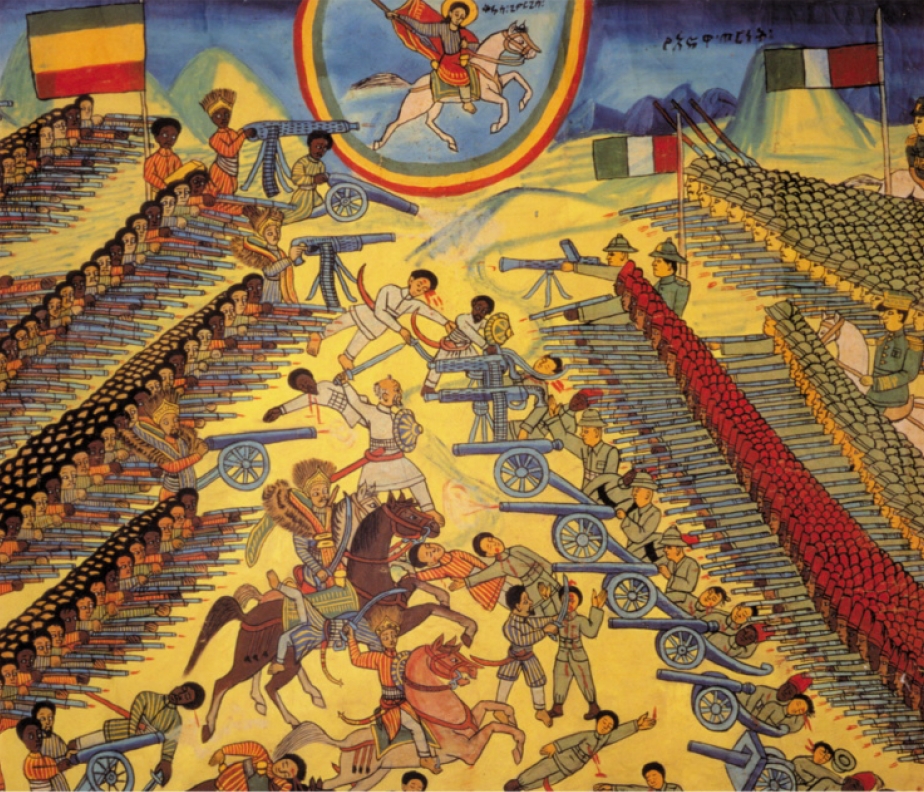Image: Holy Adowa! January 22, 2011
Author: Beach Combing | in : Modern , trackbackMemo to any budding generals: never invade Russia in the winter, never start a land war in Asia and, most relevant for today, never presume to colonise Ethiopia…Italy unfortunately never learnt this lesson. In 1935 the Italian invasion would mark the beginning of the end for Mussolini’s regime. While in 1896 an Italian attack ended in bloody Adowa the subject of the remarkable image above, the only time in the nineteenth century that a sub-Saharan army defeated a major European power.
Adowa itself is quickly told. In 1896 Italy’s corrupt political class pushed an inadequate Italian army under General Baratieri, one of a long line of incapaci who have dishonoured the Italian army and spent the lives of Italian servicemen like casino chips, into a rapid advance against Ethiopian forces. The Abyssinians under Menelik II had gathered almost six times as many troops as the Italians and yet the Italians, through delusions of grandeur and a little Latin idiocy, hurled their small army at the Ethiopians expecting an easy victory. The Abyssinians armed with (often Italian) rifles made hay. Of about 18000 Italians and allies, only 8000 managed to make their way back to the coast and the Italian colonies there.
Beachcombing particularly likes the image above because it tells the Ethiopian side of the story. One of a series recording and celebrating the Africans’ victory it is an irresistible combination of the medieval and modern. The matchstick men are using swords and on horseback, there is no perspective to speak of: yet the ‘toy’ soldiers are also firing canon, rifles and primitive machine guns.
Best of all though is the saint – presumably St George? – riding on a ‘pegasus’ in a rainbow bubble: one of a long series of heroes who have accompanied victorious armies, at least in the imagination of superstitious and hopeful warriors. Abyssinia was, of course, a Christian country and had been for centuries – for far longer than say Germany. Menelik, indeed, was praying to the God of the gospels when he heard of the Italian’s advance.
That even 8000 Italians escaped was due to a recent horse disease that had virtually destroyed the Abyssinian cavalry. The Abyssinians would have otherwise cut off, with great pleasure, the retreating Europeans. Beachcombing has always been grateful for that bout of horse measles because among the 8000 fleers was Mrs B.’s great grandfather, not yet married. Beachcombing’s life would be very different today – incalculably worse though with more time to play computer games – if one obscure Venetian noble man had not made it back across the border.
The Italian prisoners were, in fact, for the most part, treated well. But pity their native auxiliaries. The Abyssinians here showed their medieval side.
The Italian native prisoners, soldiers in the Italian service who had fought against the Abyssinians, were tried by a council of war consisting of all the chief Abyssinian leaders, and the horrible sentence of mutilation was passed… The sentence of mutilation — that is, the cutting off the right hand and left foot – is the customary punishment for the offences of theft, sacrilege and treason, of which many of these men were judged to be clearly guilty…. The sentence was carried out in the different camps, but nearly eight hundred of them were operated on at the same place, on the slope from Fremona down to the Assam Sclado river, and the severed hands and feet put in a pile. I [British traveller] saw it when I visited Adowa, a rotting heap of ghastly remnants. The joint of wrist and ankle are articulated and the stumps plunged into boiling fat to stop the haemorrhage; the wound then heals over, and afterwards a piece of the stump of the bone that is destroyed by the contact with the boiling fat comes away. I saw hundreds of these poor people who had survived the operation, and I was enabled, after crossing the Italian frontier, to send several of them back to their homes in the Hamasen. The neighbourhood of Adowa was full of their freshly dead bodies; they had generally crawled to the banks of the streams to quench their burning thirst, where many of them lingered unattended and exposed to the elements until death put an end to their sufferings. At some places the bodies were close together, as if they had sought comfort in one another’s society, and the missing members plainly told to whom the bodies belonged. In Captain De Martino’s house, that used to be the Italian Residency, there must have been some thirty bodies of these wretched people; three at the well in the garden, where they died, evidently trying to procure water, and in the small summerhouse there were seven, six belonging to natives and one to an Italian, and what a horrible death the last of them must have suffered, surrounded by their dead companions.
Beachcombing is always on the look out for notable historical images: drbeachcombing AT yahoo DOT com



